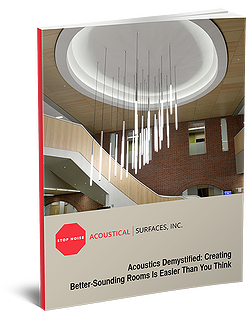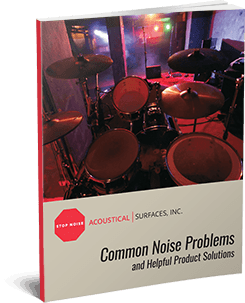Soundproofing in Esports Arenas & Gaming Studios
Soundproofing in esports arenas has quickly become a top priority as competitive gaming expands into larger venues and high-tech studios. In these environments, clear communication between teammates, uninterrupted focus for players, and full immersion for audiences depend heavily on managing sound quality.
However, effective sound control is no easy task–esports spaces often face challenges such as high-decibel gameplay audio, live streaming setups with sensitive microphones, and overlapping noise sources on open tournament floors. Without proper acoustic planning, these factors can create a distracting environment that undermines both player performance and spectator experience.
Why Soundproofing Matters in Esports Spaces
In competitive gaming, sound can be the difference between victory and defeat. Poor arena acoustics don’t just create an unpleasant environment–they can actively disrupt player focus, communication, and performance. Too much background noise makes it harder for players to pick up on in-game sounds, which adds stress and makes it tougher to stay focused. Even slight distractions can delay reaction times or cause teams to miss important audio triggers like footsteps or ability activations.
For team-based esports, voice clarity is just as important as the game audio, as chatter from adjacent booths or gaming pods can cause miscommunications. Without proper noise control, those small errors ripple into lost rounds and frustrated players.
Soundproofing also plays a major role in the audience experience. Echoes, reverb, and uncontrolled reflections muddy commentary and reduce the intelligibility of shoutcasters. Clean, isolated audio not only helps spectators in the arena but also ensures a higher-quality broadcast for those watching online. By investing in well-designed acoustic treatments, venues ensure both competitive integrity and entertainment value.
Common Acoustic Challenges in Gaming Arenas
Designing sound environments for esports isn’t as simple as turning down the volume or hanging a few panels on the wall. Competitive venues and gaming studios face unique acoustic challenges that stem from their size, layout, and the high-energy nature of esports tournaments. Understanding these challenges is the first step in creating a space where both players and audiences can thrive.
Open Floorplans and Reflective Surfaces
Most large venues–from convention centers to stadium-style arenas–rely on open floorplans with tall ceilings and hard, reflective surfaces. Materials like concrete, glass, and metal may look nice, but they amplify reverberation. The result is a long RT60 in esports arenas (the time it takes for sound to decay), which can blur speech and make commentary difficult to understand. Without proper absorption or acoustic clouds for large rooms, echoes can carry across the entire floor, making their way into player pods, caster booths, and even live streams. For venue managers and production crews, understanding how to reduce echo in esports venues is one of the most effective steps for improving both player communication and broadcast quality.
High SPL from Equipment and Crowds
Esports events combine multiple loud sound sources: gameplay audio blasting through headsets, powerful PA systems, casters hyping up matches, and thousands of cheering fans. These overlapping sources create extremely high sound pressure levels (SPL). Without smart live esports venue noise control strategies, all this noise can lead to fatigue for both players and spectators.
Sound Bleed Between Gaming Pods or Rooms
Even in smaller gaming studios or local tournament setups, sound bleed is a persistent issue. Thin walls or insufficient isolation allow communication from one pod or team room to leak into another. This not only distracts players but also poses unfair advantages if teams overhear enemy callouts. Proper gaming pod sound isolation and the use of dense barrier materials like MLV for arena walls are essential for preventing crosstalk and maintaining fair play.
Key Soundproofing and Acoustical Goals
Once the challenges are identified, the next step is setting clear goals for how an esports arena or gaming studio should sound. Effective design isn’t about eliminating noise entirely–it’s about controlling it. The aim is to create distinct acoustic “zones” that allow players, casters, and audiences to experience sound in the way that best serves their role.
- Isolate Sound Environments
Competitive areas need separation from each other to prevent crosstalk and noise bleed. This can be achieved with partition walls, floating booths, or a soundproof booth for gaming that uses dense materials like Mass Loaded Vinyl (MLV) or layered drywall with Green Glue applications. By isolating one zone from another, each team can focus on its own gameplay without distraction.
- Control Reverb and Reflections
Long reverb tails (high RT60) blur speech and reduce clarity. Treating ceilings, upper walls, and corners with absorptive materials–such as acoustic clouds, fabric-wrapped panels, and basstraps–ensures speech remains crisp and game audio remains precise. Lowering RT60 into the 0.5-0.8 second range greatly improves team communication and shoutcaster intelligibility.
- Dampen Vibrations and Low-Frequency Build-Up
Esports stages often sit on risers or temporary platforms that transmit vibrations when fans stomp, players move, or bass-heavy sound effects hit. Using isolation mounts, vibration pads, or underlayment materials beneath gaming setups prevents this rumble from carrying through the structure. In addition, low-frequency noise control with basstraps keeps heavy sounds like explosions and music cues from overpowering speech frequencies.
- Optimize the Spectator and Broadcast Experience
For the audience, the goal isn’t silence, but immersion. Proper tournament sound setup balances the excitement of the crowd noise with clean commentary and in-game audio. Controlled acoustics also make the job easier for production crews handling broadcasting and streaming audio, where mic bleed and uncontrolled reverb can ruin the listening experience.
Best Products for Esports Soundproofing
Creating professional-quality sound environments in esports tournaments and gaming studios requires more than just generic foam panels. Purpose-built solutions ensure noise control, isolation, and absorption across the full frequency spectrum. Below are some of the most effective soundproofing and acoustic treatments for arenas, pods, and broadcast spaces–with proven applications in competitive gaming.
Soundproofing Barriers
When the goal is pod-to-pod isolation or preventing noise bleed between rooms, dense barriers are essential.
- Mass Loaded Vinyl (MLV) for arena walls: A flexible, high-density barrier that when used on studs or joists before drywall is installed, blocks airborne noise between pods, practice rooms, and staging areas.
- Green Glue applications: Applied between layers of drywall, this compound dissipates vibrational energy and dramatically increases wall performance without requiring major structural changes.
- Resilient Sound Isolation Clips (RSIC): Used for both walls and ceilings, RSIC systems decouple drywall from framing, minimizing structural sound transmission and are the most effective way to achieve pro-level results.
Acoustic Absorption Panels
For managing echoes and reflection in control rooms, lounges, and streaming rooms, absorption panels are essential.
- Fabric-wrapped panels: Versatile and customizable, these panels reduce mid- and high-frequency reflections, improving speech clarity.
- Sound Silencer™ PEPP panels: Durable, impact-resistant panels designed for public spaces such as convention halls or team practice bays.
- Poly Max™ PET Felt Panels: Eco-conscious, durable panels made from recycled plastic bottles that provide excellent absorption in gaming lounges and acoustic treatment for streaming rooms.
Ceiling Clouds and Baffles
Large venues require overhead solutions to handle long reverberation times.
- Acoustic clouds for large rooms: Hung from ceilings above the main floor or stage, these reduce reverb across open spaces and improve arena acoustics.
- Baffles: Suspended vertically from ceilings in convention centers or practice areas, they break up sound waves and minimize bleed across open bays.
Quick Reference: Acoustic Goals & Recommended Products
| Acoustic Goal | Recommended Product(s) |
| Pod-to-pod isolation | MLV, RSIC Clips, Green Glue |
| Reverb reduction | Acoustic Clouds, Fabric-Wrapped Panels |
| Streaming room clarity | Poly Max™ PET Felt Panels, Sound Silencer |
| Vibration Dampening | Anti-vibration floor underlayment, isolation mounts |
Acoustic Treatment for Streaming & Shoutcasting Studios
While main stages and open floors dominate the spotlight, the shoutcaster studio and streaming control rooms are just as important to an esport event’s success. These spaces require precision acoustics: every word from a caster and every reaction to a live stream must come through clearly, free from echoes or background noise.
Control Room & Caster Booth Setup
A professional caster booth soundproofing strategy starts with treating wall and ceiling reflections. Installing acoustic panels for gaming setups behind speakers prevents reflections from bouncing directly back into sensitive microphones. Adding basstraps in corners controls low-frequency buildup, which can otherwise make voices sound boomy or muddy. For maximum isolation, sealing gaps around doors and windows with acoustic gasketing or secondary barriers helps block noise bleed from nearby arenas or production spaces.
Mic Environment Optimization
Microphones used in broadcasting and streaming audio are highly sensitive, often picking up even the smallest flutter echo. A mix of absorption and diffusion keeps the vocal tone natural while eliminating reverb tails. Acoustic diffusion panels scatter sound energy to avoid “dead” recording environments, while absorption panels manage mid- and high-frequency reflections. For acoustic treatment for streaming rooms, a combination of wall-mounted absorption, overhead panels, and rugs can turn any room into a broadcast-ready space.
Pro Tips for Soundproofing New vs. Existing Gaming Spaces
Not every esports venue is built from the ground up. Some tournaments take place in custom-designed arenas, while others are hosted in convention centers or retrofitted gaming studios. The approach to soundproofing will vary depending on whether you’re starting fresh or working with an existing space.
New Construction
Building from scratch is the best way to integrate sound isolation into the structure itself.
- Integrate soundproofing in framing stage: Incorporate Green Glue applications and double-stud or staggered stud walls during the framing stage to maximize isolation without major cost increases later.
- Raised floors and dropped ceilings: These structural elements can conceal MLV for arena walls, acoustic insulation, or cable management systems, while also helping control tournament sound setup.
- Built-in acoustic treatments: Designing spaces with absorptive surfaces, recessed acoustic clouds, and partition walls ensures that reverberation and noise bleed are controlled from day one.
Retrofit Studios or Convention Centers
When working in existing venues, flexible and modular materials are essential.
- Portable panels & baffles: Freestanding acoustic barriers and ceiling baffles are ideal for temporary setups in convention centers, where permanent construction is not possible.
- Acoustic curtains and modular kits: Large fabric barriers and modular wall systems provide quick gaming pod sound isolation between competitive zones and can be repositioned as tournament layouts change.
- Acoustic panel kits for streaming rooms: Pre-packaged absorption kits, including wall panels and basstraps, can quickly improve streaming audio quality in control rooms or studios.
Get Game-Ready with Acoustical Surfaces
In esports, sound is just as important as visuals. Clear arena acoustics, controlled noise bleed, and well-placed acoustic treatments ensure players stay focused, casters sound sharp, and audiences stay immersed.
Acoustical Surfaces provides proven solutions for soundproofing in esports arenas and gaming studios–from MLV for arena walls and Green Glue applications to acoustic clouds for large rooms. If you’d like to learn more about tailoring our solutions to meet your needs, reach out to one of our dedicated team members. We’d love to help.







